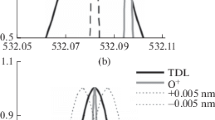Abstract
RAMAN-shifted backscatter of laser radar radiation from atmospheric constituents in the troposphere has been reported1–3. Signals from nitrogen have been detected up to heights of about 6 km and there have been indications of backscatter at even greater heights4. Oxygen and water vapour have also been the subject of tropospheric Raman investigations, generally using frequency doubled ruby (0.3472 µm) as the laser transmitter.
Similar content being viewed by others
References
Leonard, D. A., Nature, 216, 142 (1967).
Cooney, J., Orr, J., and Tomasetti, C., Nature, 224, 1098 (1969).
Melfi, S. H., and Lawrence, J. D., jun., Appl. phys. Lett., 15, 295 (1969).
Melfi, S. H., thesis, The College of William and Mary, (1970).
Kent, G. S., Sandland, P., and Wright, R. W., J. appl. Meteorol., 10, 443 (1971).
US Standard Atmosphere Supplements, 1966 (US Government Printing Office, Washington, DC).
Guide to Meteorological Instruments and Observing Practices, fourth ed., No. 8. TP. 3 (World Meteorological Organisation, Geneva, 1971).
Author information
Authors and Affiliations
Rights and permissions
About this article
Cite this article
GARVEY, M., KENT, G. Roman backscatter of Laser radiation from the stratosphere. Nature 248, 124–125 (1974). https://doi.org/10.1038/248124a0
Received:
Issue Date:
DOI: https://doi.org/10.1038/248124a0
- Springer Nature Limited
This article is cited by
-
Remote air pollution measurement
Optical and Quantum Electronics (1975)





